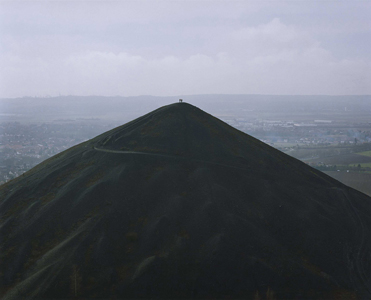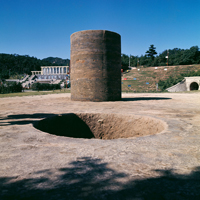You are in: Home page > Magazine Archive > Collateral Geographies

Marcello Tavone
Collateral Geographies
Dizziness and disturbances of the memory

Naoya Hatakeyama, Lime works, 2008
“The territory, overloaded as it is by traces and readings imposed upon it, looks more like a palimpsest. (...) Some areas, treated brutally and improperly, are full of holes, like a parchment that has been scraped too much: in the local language, these holes are called deserts.” 1
André Corboz, Le territoire comme palimpseste, 1981
It was 25 May 1996, and until that day, Noeux-les-Mines, a small town with 10,000 inhabitants in northern France, was known only for having the first store ever built by the French colossus Leroy Merlin, a large multiple founded by a local family. That day, the socialist mayor, Jacques Villedary, accompanied by the entire executive committee of the municipality and former Olympic freestyle skiing champion, Edgar Grospiron, was preparing to give an opening address that he could never have imagined giving in his twenty-year political career, but which would bring the town another national record. He was ready to announce to his fellow citizens and others from the whole of Nord-Pas-de-Calais, the official opening of “Loisinord”, the lowest ski resort in France.
Despite being only 129 metres above sea level, the Loisinord peak is one of the highest points in the entire region, whose gentle landscape typically consists of shallow slopes that rarely rise above one hundred metres. The new Noeux-les-Mines ski resort, on the contrary, lies on the summit of a hill, similar to an enormous pile of earth, with an atypical shape that is almost forsaken by the rolling countryside around it. In fact, as the mayor Villedary mentioned in his speech, Losinord had been built not on top of a hill, but on a terril, i.e. a spoil tip left over from coal mining. In the Nord-Pas-de Calais alone there are around 300 of these, but they are only a small section of a much larger chain that stretches from Wales to the Ruhr by way of France and Belgium, running above the same carboniferous bed that unites these countries’ industrial past. Terrils are quite literally a collateral landscape, being the not totally expected result of a by-now extinct primary industrial activity, of which they represent not only a leftover but also a monument. And it was precisely the concepts of memory, heritage and local identity that the words of Jacques Villedary’s speech concentrated on, just before turning on the Loisinord skilifts.
Side effect #1: hyperthermia.
Definition: Hyperthermia consists in an increase in body temperature compared to normal values.
The origin of the word terril has ancient origins that seem to date back to 1300 when the term was used in Wallonia to indicate deposits of waste near a mine. The name seems to have come from the Frennch “steril”, i.e. sterile, indicating – and stigmatizing – its inert unproductive nature right from the start. In October 2013, an article in “Le Figaro” announced in clamorous tones the production of a new wine, which was defined as “audacious”. What most struck the journalist›s interest was the fact that the small vineyard stretched across the slopes of Terril B2 at Haillicourt, a mining site in northern France. This is arguably the most curious case of the landscape reconversion of these artificial hills which, over the last twenty years, have captured the interest of both local experts and populations thanks to their significant floral and faunistic biodiversity. Perhaps the most peculiar feature of the terrils is their temperature, which is up to 5 degrees higher than that of their surroundings. This thermal anomaly partially depends on their dark colour, which traps solar radiation, and on internal combustion processes due to the presence of coal. And so the terrils are “hot islands”, on which grow thermophile plant species that are normally to be found in other types of habitat. In some cases, they are covered in pomaceous orchards, probably born from old apple cores that the miners tossed into loading and unloading wagons.
Side effect #2: dizziness
Definition: Dizziness is a symptom that comes from a distortion in the relationships that normally exist between our body image and its surroundings.
At the end of the Sixties, the well-known exhibition “Earthworks” was to open one of the most important chapters in contemporary art, that of Land Art. The group show at the Dwan Gallery presented works that were very different from one another, but were united by the principle that the site of their interventions symbolized not only the place but the material used. Minimal modifications to the landscape can bring about new perception by changing the reference systems. In that same period, Europe was seeing a rapid process of de-industrialization, that would result in a passage from Ford to post-Ford production models. The traces of this industrial era left on the land can be compared to a series of monumental earthworks that have changed the existing natural landscape for ever. In fact, the terrils, just like the works of Michel Heizer or Nabuno Sekine, are the result of a simple shifting of soil. This action, as “minimalist” and primitive as it is, has been able to add a new layer to the complex palimpsest of the territories of northern Europe, becoming inescapable landmarks in the memory of these places.
Side effect #3: ecmnesia
Definition: Ecmnesia is a disturbance of the memory, of a hallucinatory type, in which certain subjects live memories of the past as current experiences: in other words, the past manifests as if it were the present.
In a short film made by the BBC in 1966, we can find images of one of the most tragic catastrophes in the industrial history of Wales. At a quarter past nine on 21 October that year, after three days of relentless rain, the terril of Tip number 7 in Aberfan collapsed onto the village’s buildings burying 144 people. This was arguably the most acute moment in the tensions that had accumulated between the local population and these “black mountains”, which in Wales, as in other European countries, had come to symbolize an era of poverty, exploitation, and social inequality. Terrils have an unstable structure, which means they are dangerous; they are toxic and when their dust rises it blackens the façades of the surrounding houses; but more than anything else, they are the “inert” residue of a past that many would rather forget. In April 1967, just a few months after the Aberfan disaster, the Spellbrook primary school in England organized fund-raising to plant trees on a terril, transforming it into what they called the “Aberfan Memorial Forest Plot”. This simple, ready-made remedy showed how terrils could find a new role in the landscape, and above all how they could take on new meaning. This was the start of a slow process to repossess these places, initially on the part of local populations, and later by media culture. Terrils featured in the sets of the film Lust for Life starring Kirk Douglas; in the ‘70s they were celebrated in the songs of Edmond Taniere, and from the ‘80s onwards, thanks to a renewed interest in industrial archaeology, they began to be considered no longer as spoil tips, but as monuments of a heritage to be conserved and re-evaluated.
On Saturday 30 June 2012, the offices of the BMU – the United Mining Basin Association – received news they had waited 10 years to hear: on that day, the 21 member states of the UNESCO commission meeting in Saint Petersburg had decided to grant the mining basins of the Nord-pas des Calais and Wallonia World Heritage Site status, in order to conserve this formidable “Evolving Cultural Landscape”. The BMU chair celebrated the event by announcing to the press that «Where we live, the landscapes are not made of pink granite, crystalline seas or snow-clad peaks. Where we live, man has excavated, mined, and built mountains... this is a human story founded on such values as courage, simplicity, and solidarity.» 2
1 “Le territoire, tout surchargé qu’il est de traces et de lectures passées en force, ressemble plutôt à un palimpseste. (...) Certaines régions, traitées trop brutalement et de façon impropre, présentent aussi des trous, comme un parchemin trop raturé: dans le langage du territoire, ces trous se nomment des déserts.” André Corboz, Le territoire comme palimpseste, 1981
2 “Chez nous les paysages ne sont pas faits de granit rose, de mer limpide ou de sommets aux neiges éternelles. Chez nous l’homme a creusé, extrait, construit des montagnes c’est une histoire humaine construite sur des valeurs telles que le courage, la simplicité, la solidarité.”
Marcello Tavone is an architect and urban designer, co-founder of Weltgebraus. He graduated from the IUAV in Venice in 2011 and is currently curating Dominique Perrault's research platform DPAx.














